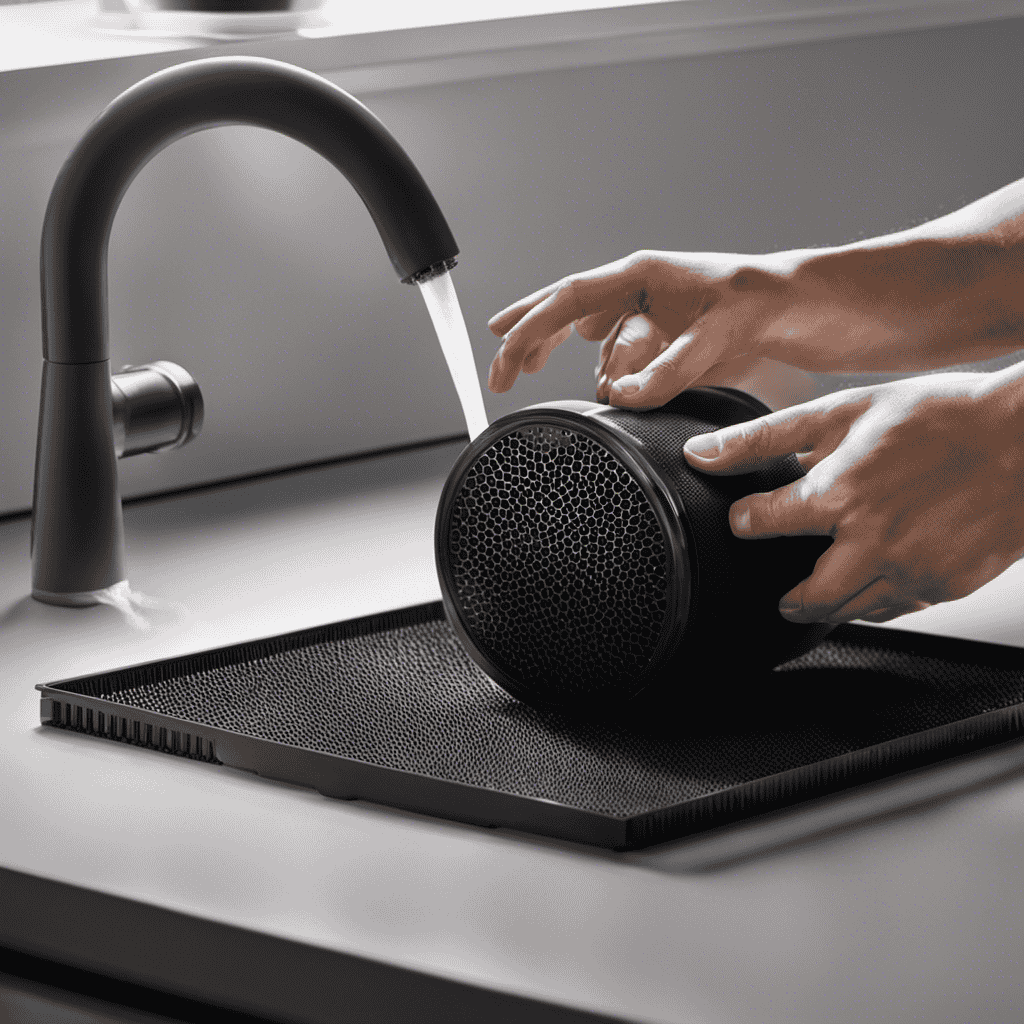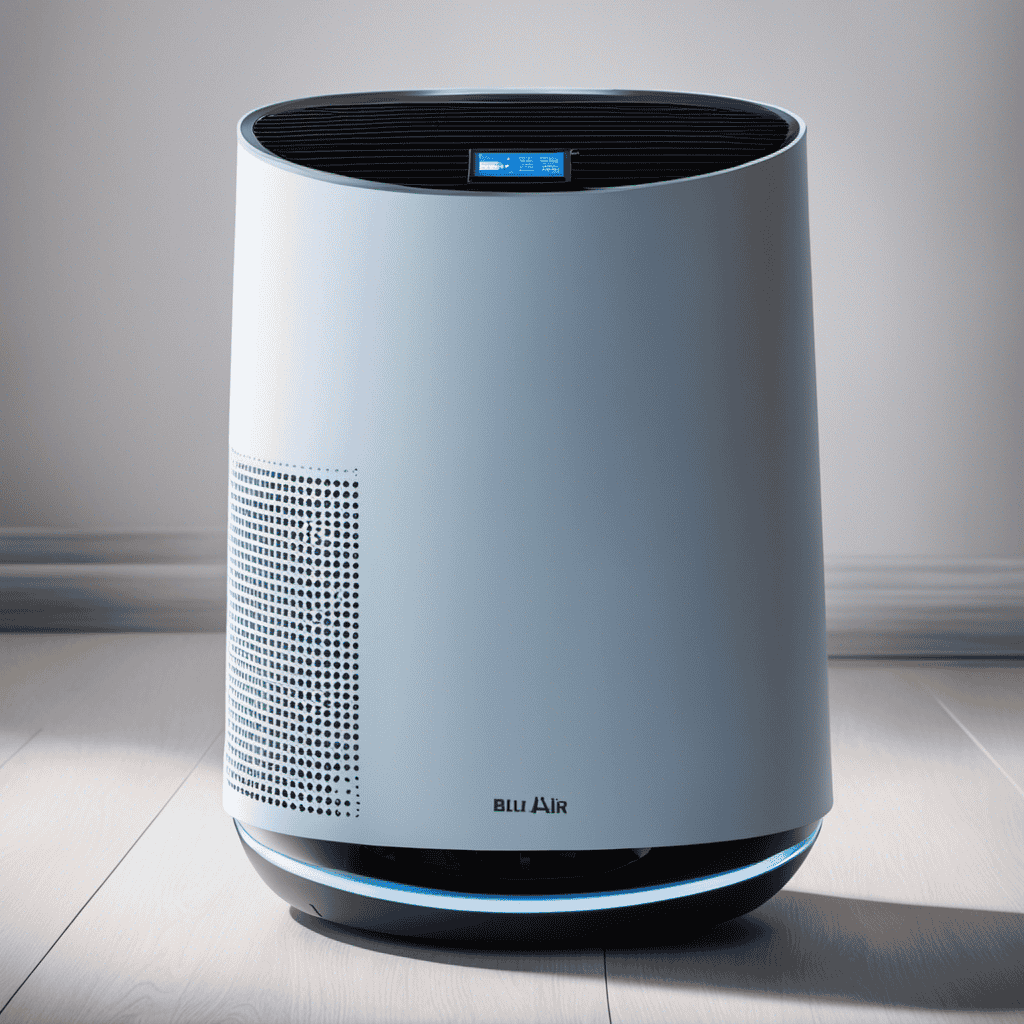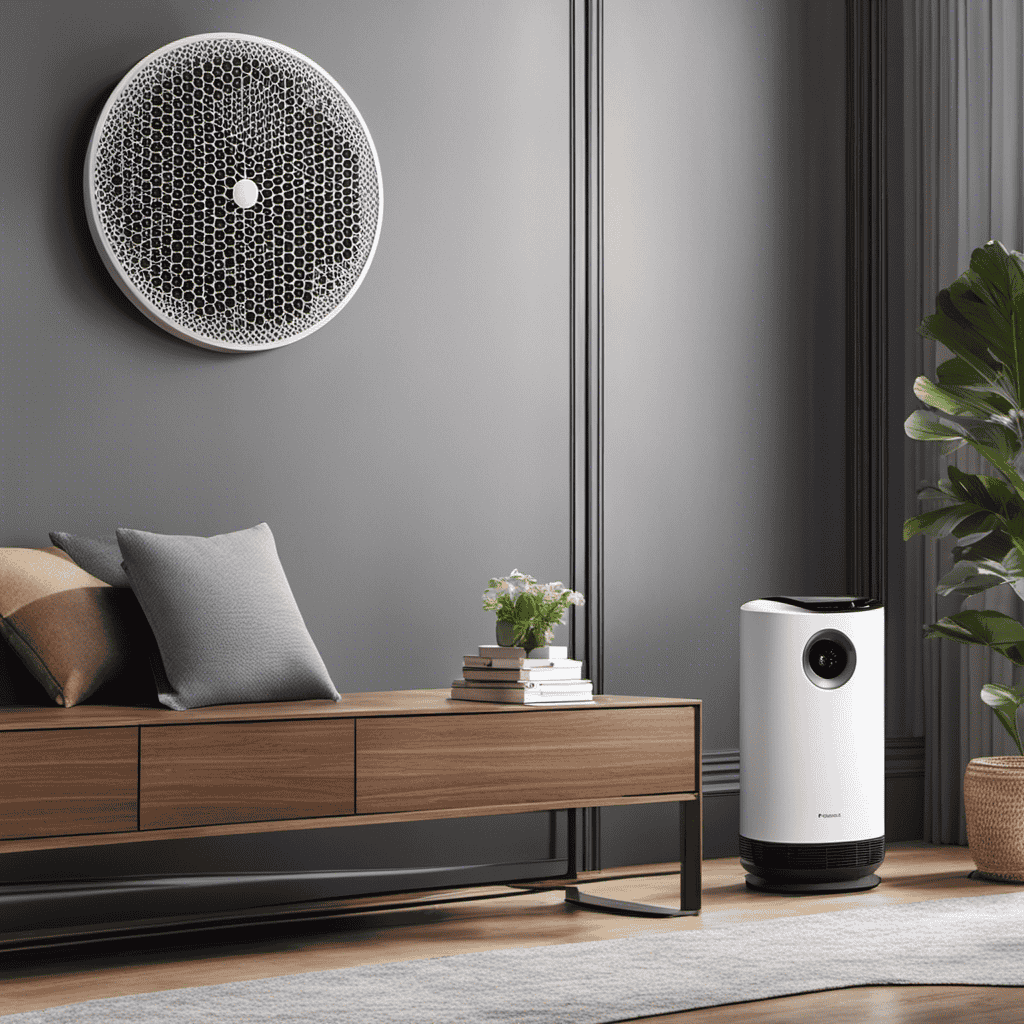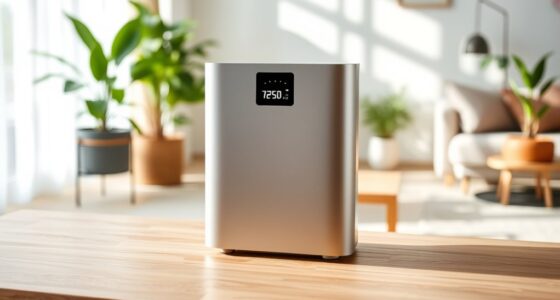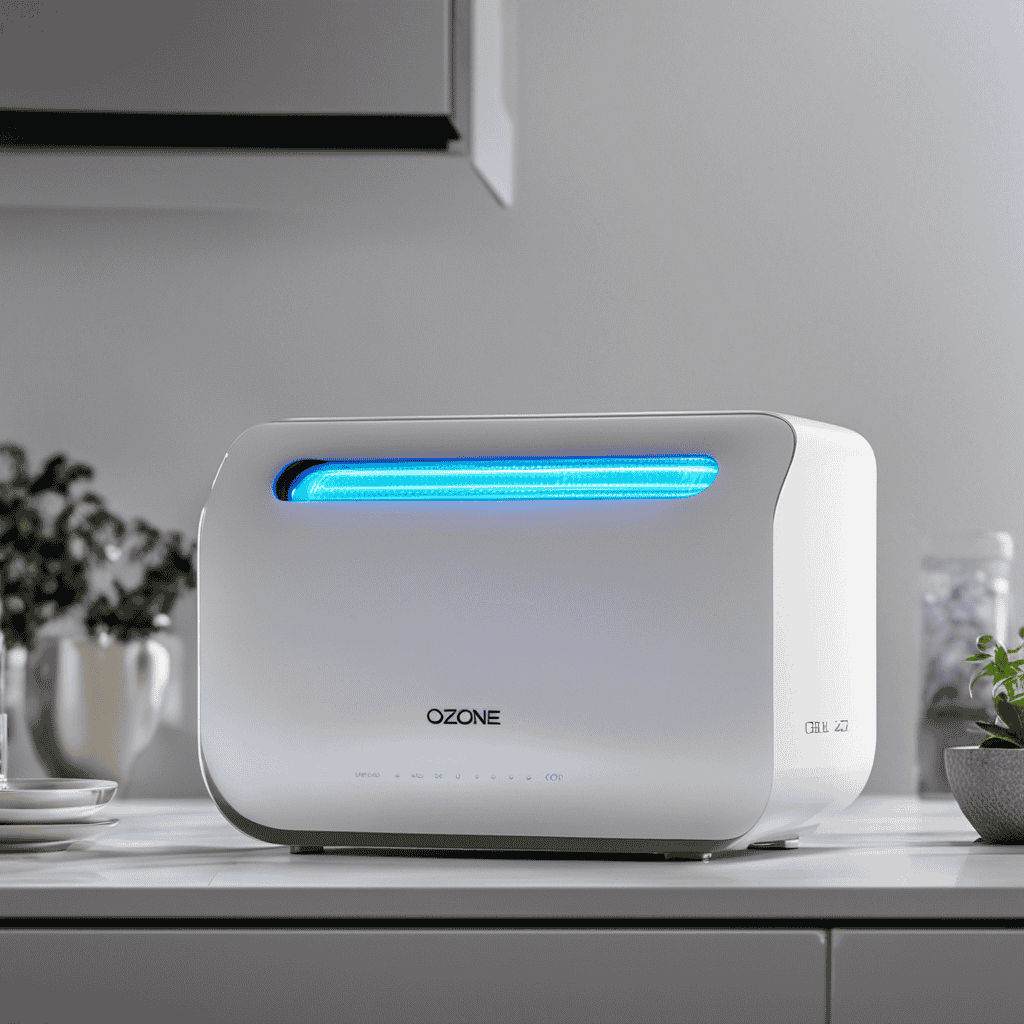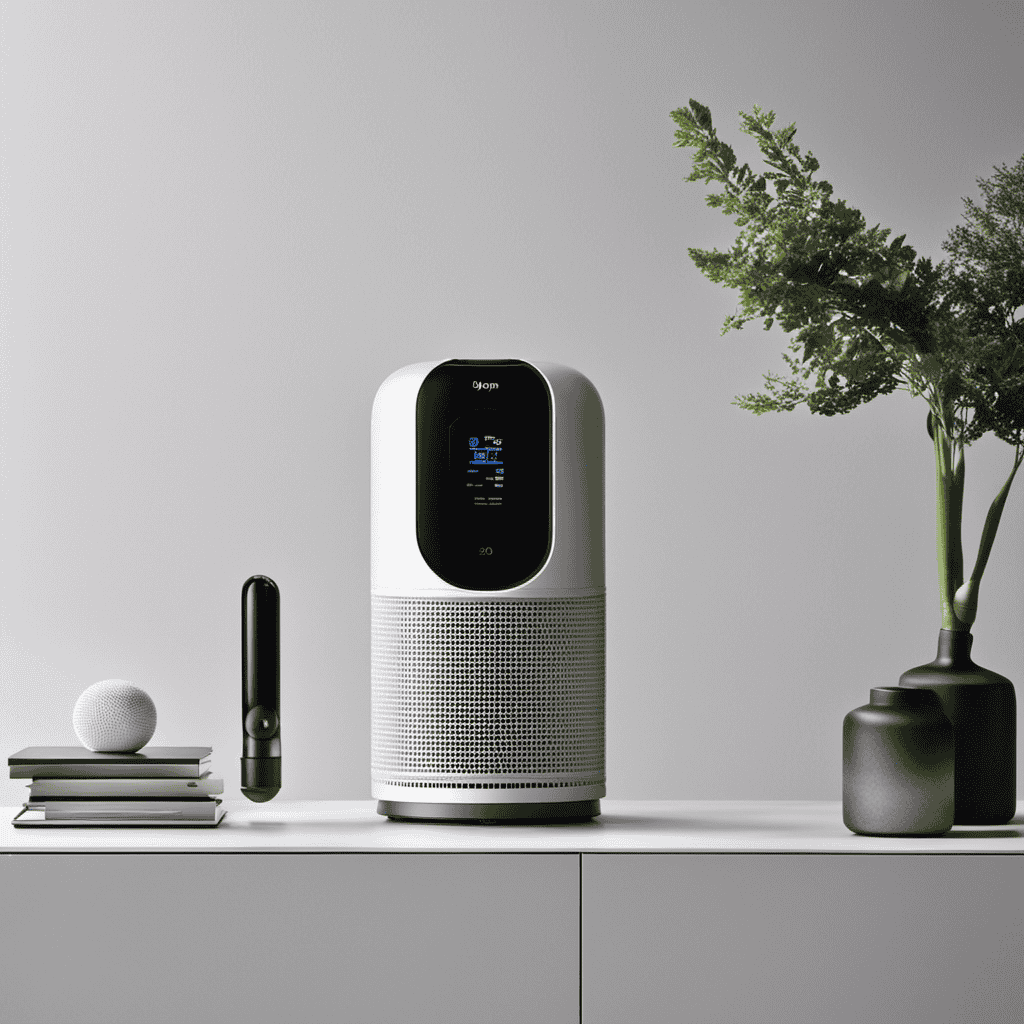I’m here to share my proven method for cleaning a charcoal filter in an air purifier.
Let’s face it, over time these filters can become clogged with dirt and debris, compromising the effectiveness of your air purifier.
But fear not! With a few simple steps and some basic tools, you’ll have your charcoal filter looking and functioning like new in no time.
So, let’s dive in and get that air in your home fresh and clean again!
Key Takeaways
- Regular cleaning of the charcoal filter ensures optimal function of the air purifier and improves indoor air quality.
- The charcoal filter can be cleaned using tools such as a vacuum cleaner, soft brush, or soaking in warm water and mild detergent.
- Proper handling and disposal of the dirty filter should be done following local regulations and considering environmentally friendly alternatives.
- Air drying the cleaned filter is important to prevent mold or bacterial growth and maintain its effectiveness.
Importance of Cleaning the Charcoal Filter
Cleaning the charcoal filter is essential for maintaining the effectiveness of the air purifier. Regular maintenance is important because it ensures that the filter continues to function optimally. The charcoal filter plays a crucial role in removing odors, chemicals, and pollutants from the air, making it cleaner and healthier to breathe. By trapping harmful particles, the filter helps improve indoor air quality, reducing the risk of respiratory issues and allergies.
Additionally, using a charcoal filter can also help eliminate unpleasant smells, such as smoke or cooking odors, creating a more pleasant living environment. Cleaning the charcoal filter regularly ensures that it remains unclogged and can continue to provide these benefits.
Now, let’s move on to the tools and materials needed for cleaning.
Tools and Materials Needed for Cleaning
To properly maintain it, you’ll need a few tools and materials. When it comes to cleaning your charcoal filter for an air purifier, there are certain items that are essential.
Firstly, you’ll need a vacuum cleaner with a brush attachment to remove surface dirt and debris. This will help prolong the life of your filter and improve its efficiency.
Additionally, a soft brush or toothbrush can be used to gently scrub away any stubborn dirt or residue.
For a thorough clean, you may also consider using alternative cleaning methods such as soaking the filter in a mixture of warm water and mild detergent. However, be sure to thoroughly rinse and air dry the filter before reinstalling it.
These cleaning techniques, combined with regular maintenance, will ensure that your charcoal filter continues to effectively remove impurities from the air in your home.
Step-by-Step Guide to Removing the Charcoal Filter
When removing the charcoal filter, it’s important to follow these step-by-step instructions.
- Turn off the air purifier and unplug it from the power source to ensure safety.
- Locate the filter compartment and carefully open it using the designated latch or screws.
- Gently pull out the charcoal filter, being cautious not to damage it.
- Inspect the filter for any stubborn stains. If there are stains, here are some tips for removing them:
- Mix a solution of warm water and mild soap and gently scrub the stained areas.
- Alternatively, you can try using a mixture of vinegar and water to remove stubborn stains.
- For tough stains, consider using a specialized stain remover product.
- Allow the filter to air dry completely before reinserting it into the air purifier.
Proper Handling and Disposal of the Dirty Filter
It’s important to handle and dispose of the dirty filter properly to avoid any potential contamination. When it comes to disposing of a dirty charcoal filter for an air purifier, there are certain regulations that need to be followed.
Many localities have specific disposal regulations in place for filters containing activated charcoal due to their potential environmental impact. It’s crucial to check with your local waste management facility or municipality to understand the proper disposal method in your area.
Additionally, it’s worth exploring environmentally friendly alternatives for disposing of the filter. Some options include recycling programs that accept activated charcoal filters or finding ways to repurpose the filter in a safe and responsible manner.
Now let’s move on to the methods for cleaning the charcoal filter.
Methods for Cleaning the Charcoal Filter
When it comes to cleaning a charcoal filter for an air purifier, there are several effective methods to consider.
One method is soaking the filter in water, which helps to loosen and remove dirt and debris.
Another option is using a vinegar solution, which can help break down and remove any stubborn stains or odors.
After cleaning, it is important to air dry the filter thoroughly to prevent any potential mold or bacterial growth.
Soaking in Water
To clean the charcoal filter for your air purifier, you can start by soaking it in water. This method is effective in removing odors and maintaining the benefits of activated charcoal.
Here’s a step-by-step guide:
- Remove the charcoal filter from the air purifier.
- Fill a basin or bucket with warm water.
- Submerge the filter in the water and gently agitate it to loosen dirt and debris.
- Let the filter soak for 15-20 minutes to allow the water to dissolve and remove impurities.
Soaking the charcoal filter in water helps to wash away accumulated dirt and grime, ensuring that it continues to effectively absorb odors and harmful particles from the air.
Once you’ve completed this step, you can move on to the next section, which involves using a vinegar solution to deep clean the filter.
Using Vinegar Solution
Once you’ve finished soaking the charcoal filter in water, you can proceed to using a vinegar solution for deep cleaning. Vinegar is a versatile cleaning agent that is effective in removing dirt, grime, and odors from various surfaces. When it comes to cleaning a charcoal filter, vinegar can help to eliminate any lingering smells and bacteria that may have built up over time.
To use vinegar for cleaning your charcoal filter, follow these steps:
- Mix equal parts of vinegar and water in a spray bottle.
- Spray the vinegar solution onto the dirty areas of the filter.
- Allow the solution to sit for a few minutes to break down any stubborn residue.
- Rinse the filter thoroughly with clean water to remove any vinegar residue.
Here is a table that compares vinegar with other cleaning solutions:
| Cleaning Solution | Benefits | Drawbacks |
|---|---|---|
| Vinegar | Natural, effective, affordable | Strong smell, may not be suitable for all surfaces |
| Baking Soda | Natural, deodorizing | May not be as effective on tough stains |
| Lemon Juice | Natural, fresh scent | Can cause discoloration on certain surfaces |
| Hydrogen Peroxide | Kills bacteria, disinfects | May bleach fabrics or surfaces |
When it comes to cleaning your charcoal filter, vinegar is a great option to consider. However, if you prefer to use other cleaning solutions, make sure to read the manufacturer’s instructions and test the solution on a small, inconspicuous area before applying it to the entire filter.
Air Drying After Cleaning
After cleaning your charcoal filter, it’s important to let it air dry completely before reinstalling it in your air purifier. Air drying is a simple and effective method that allows the filter to dry naturally without the use of any additional tools or equipment.
Here are the benefits and drawbacks of air drying:
-
Preserves filter quality: Air drying helps maintain the integrity and effectiveness of the charcoal filter, as excessive heat from a hair dryer can potentially damage the filter material.
-
Energy-efficient: Air drying requires no electricity, making it a more environmentally friendly and cost-effective option compared to using a hair dryer.
-
Time-consuming: Air drying can take longer than using a hair dryer, as it relies on natural air circulation to dry the filter completely.
-
Dependence on weather conditions: Air drying may be affected by external factors such as humidity and temperature, which can prolong the drying process.
Overall, air drying is a reliable method for drying your charcoal filter, ensuring optimal performance and longevity.
Drying and Reinstalling the Cleaned Filter
You can now dry and reinstall the cleaned filter in your air purifier.
After you have thoroughly cleaned your charcoal filter using the recommended cleaning method, it is important to ensure that it is completely dry before reinstalling it. This will prevent any moisture from accumulating in the filter and potentially damaging it.
To dry the filter, you can simply place it in a well-ventilated area and allow it to air dry naturally. Avoid using any heat sources or placing the filter under direct sunlight, as this may cause damage. Once the filter is completely dry, you can reinstall it back into your air purifier, ensuring that it is fitted securely.
Now that you know how to clean and reinstall the filter, let’s discuss the frequency of cleaning the charcoal filter.
Frequency of Cleaning the Charcoal Filter
It’s important to consider how often the charcoal filter needs to be cleaned in order to maintain optimal performance in your air purifier. Cleaning frequency will vary depending on factors such as the air quality in your environment and the manufacturer’s recommendations.
However, there are some signs that indicate a dirty charcoal filter that needs cleaning:
-
Reduced air flow: If you notice a decrease in the amount of air being circulated by your air purifier, it may be a sign that the charcoal filter is clogged with dirt and debris.
-
Unpleasant odors: A dirty charcoal filter can no longer effectively remove odors from the air, resulting in a lingering smell in your space.
-
Dust accumulation: If you’re finding an excessive amount of dust settling on surfaces despite regular cleaning, it could be a sign that your charcoal filter is dirty and needs to be cleaned.
-
Increased allergens: If you or your family members are experiencing an increase in allergy symptoms, it could be a sign that the charcoal filter is no longer effectively capturing allergens.
Troubleshooting Common Issues With Charcoal Filters
If your space starts to smell unpleasantly or you notice a decrease in airflow, it might be a sign that the charcoal filter needs troubleshooting.
Troubleshooting common filter issues can help you identify and fix the problem quickly.
One common issue is a clogged filter. Over time, the charcoal filter can get clogged with dust, dirt, and other particles, reducing its effectiveness. To troubleshoot this issue, remove the filter and gently tap it to remove any loose debris.
Another common issue is a damaged or worn-out filter. If you notice any holes or tears in the filter, it’s time to replace it.
Additionally, improper installation can cause airflow problems. Make sure the filter is properly aligned and securely in place.
Troubleshooting these common filter issues will help ensure that your air purifier continues to work efficiently.
Is the Cleaning Process for the Charcoal Filter the Same as for the Pre Filter in an Air Purifier?
Yes, the cleaning process for the charcoal filter is the same as for the pre filter in an air purifier. Both filters can be cleaned using a vacuum or by rinsing with water. Regular cleaning of the pre filter is essential for maintaining the efficiency of the air purifier.
Maintenance Tips for Prolonging the Lifespan of the Charcoal Filter
To ensure that your charcoal filter lasts longer, regularly replacing it at least once every six months is essential. However, there are additional maintenance best practices that can help prolong the effectiveness of your charcoal filter and extend its lifespan. Here are four important tips to keep in mind:
-
Vacuum the filter: Use a vacuum cleaner with a brush attachment to gently remove dust and debris from the surface of the charcoal filter. This will prevent clogging and ensure optimal airflow.
-
Wash with mild soap: If your charcoal filter is washable, carefully remove it from the air purifier and wash it with mild soap and water. Avoid using harsh chemicals or scrubbing too vigorously, as this can damage the filter material.
-
Allow to dry completely: After washing, make sure to let the charcoal filter dry completely before reinserting it into the air purifier. Moisture can promote the growth of mold and bacteria, reducing the filter’s effectiveness.
-
Store properly: When not in use, store your charcoal filter in a clean, dry place. Avoid exposing it to direct sunlight or extreme temperatures, as this can degrade the filter material over time.
Frequently Asked Questions
Can I Use Soap or Detergent to Clean the Charcoal Filter?
I wouldn’t recommend using soap or detergent to clean the charcoal filter. It’s best to use vinegar, which is a natural and effective cleaner. As for frequency, it’s a good idea to clean the charcoal filter every few months.
Can I Wash the Charcoal Filter in the Dishwasher?
No, the charcoal filter should not be washed in the dishwasher. Hand washing is the recommended method to clean it. There are alternative methods, such as vacuuming or using compressed air, that can also be effective in removing dirt and debris.
Can I Use a Vacuum Cleaner to Clean the Charcoal Filter?
Yes, using a vacuum cleaner is an effective alternative cleaning method for a charcoal filter. It helps remove dust and debris from the filter, ensuring it continues to function properly. This method is quick and convenient.
Can I Use a Brush or Scrubbing Pad to Clean the Charcoal Filter?
Using a brush or scrubbing pad can be an effective alternative method for cleaning a charcoal filter. It helps remove dirt and debris, improving the filter’s performance and extending its lifespan.
Can I Reuse the Dirty Charcoal Filter After Cleaning It?
After cleaning the dirty charcoal filter, it is not recommended to reuse it. Although it may seem like a cost-saving option, the cleaning effectiveness of the filter is compromised, and it may not effectively remove pollutants from the air.
Conclusion
In conclusion, cleaning the charcoal filter for your air purifier is crucial for maintaining its efficiency and prolonging its lifespan. By following the step-by-step guide and using the proper tools and materials, you can easily remove, clean, and reinstall the filter.
Remember to handle and dispose of the dirty filter properly, and be mindful of troubleshooting common issues that may arise. Regular maintenance and cleaning of the charcoal filter will ensure that your air purifier continues to provide clean and fresh air for you and your loved ones.
So, don’t delay, give your air purifier some TLC today!
